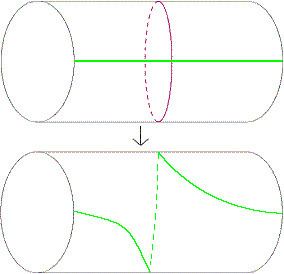 | ||
In geometric topology, a branch of mathematics, a Dehn twist is a certain type of self-homeomorphism of a surface (two-dimensional manifold).
Contents
Definition
Suppose that c is a simple closed curve in a closed, orientable surface S. Let A be a tubular neighborhood of c. Then A is an annulus and so is homeomorphic to the Cartesian product of
where I is the unit interval. Give A coordinates (s, t) where s is a complex number of the form
with
and t in the unit interval.
Let f be the map from S to itself which is the identity outside of A and inside A we have
Then f is a Dehn twist about the curve c.
Dehn twists can also be defined on a non-orientable surface S, provided one starts with a 2-sided simple closed curve c on S.
Example
Consider the torus represented by a fundamental polygon with edges a and b
Let a closed curve be the line along the edge a called
Given the choice of gluing homeomorphism in the figure, a tubular neighborhood of the curve
in the complex plane.
By extending to the torus the twisting map
This self homeomorphism acts on the closed curve along b. In the tubular neighborhood it takes the curve of b once along the curve of a.
A homeomorphism between topological spaces induces a natural isomorphism between their fundamental groups. Therefore one has an automorphism
where [x] are the homotopy classes of the closed curve x in the torus. Notice
Mapping class group
It is a theorem of Max Dehn that maps of this form generate the mapping class group of isotopy classes of orientation-preserving homeomorphisms of any closed, oriented genus-
Lickorish also obtained an analogous result for non-orientable surfaces, which require not only Dehn twists, but also "Y-homeomorphisms."
